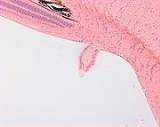
Bergmeister's papilla
Encyclopedia
Bergmeister’s papilla arises from the centre of the optic disc
, consists of a small tuft of fibrous tissue and represents a remnant of the hyaloid artery
.
The hyaloid artery provides nutrition to the lens
during development in the fetus, and runs forward to the lens from the optic disc. The optic disc is covered by a plaque of fibrous cells called the central supporting tissue meniscus of Kuhnt. This plaque forms a fibrous sheath around the hyaloid artery where it leaves the optic disc.
At birth the hyaloid artery regresses, and is normally completely regressed by the time of eyelid opening. Bergmeister’s papilla is a remnant of the hyaloid artery fibrous sheath and is frequently observed as an incidental clinical finding.
Bergmeister’s papilla is named after Austrian ophthalmologist O. Bergmeister (1845–1918).
Optic disc
The optic disc or optic nerve head is the location where ganglion cell axons exit the eye to form the optic nerve. There are no light sensitive rods or cones to respond to a light stimulus at this point. This causes a break in the visual field called "the blind spot" or the "physiological blind spot"...
, consists of a small tuft of fibrous tissue and represents a remnant of the hyaloid artery
Hyaloid artery
The hyaloid artery is a branch of the ophthalmic artery, which is itself a branch of the internal carotid artery. It is contained within the optic stalk of the eye and extends from the optic disc through the vitreous humor to the lens...
.
The hyaloid artery provides nutrition to the lens
Lens (anatomy)
The crystalline lens is a transparent, biconvex structure in the eye that, along with the cornea, helps to refract light to be focused on the retina. The lens, by changing shape, functions to change the focal distance of the eye so that it can focus on objects at various distances, thus allowing a...
during development in the fetus, and runs forward to the lens from the optic disc. The optic disc is covered by a plaque of fibrous cells called the central supporting tissue meniscus of Kuhnt. This plaque forms a fibrous sheath around the hyaloid artery where it leaves the optic disc.
At birth the hyaloid artery regresses, and is normally completely regressed by the time of eyelid opening. Bergmeister’s papilla is a remnant of the hyaloid artery fibrous sheath and is frequently observed as an incidental clinical finding.
Bergmeister’s papilla is named after Austrian ophthalmologist O. Bergmeister (1845–1918).

